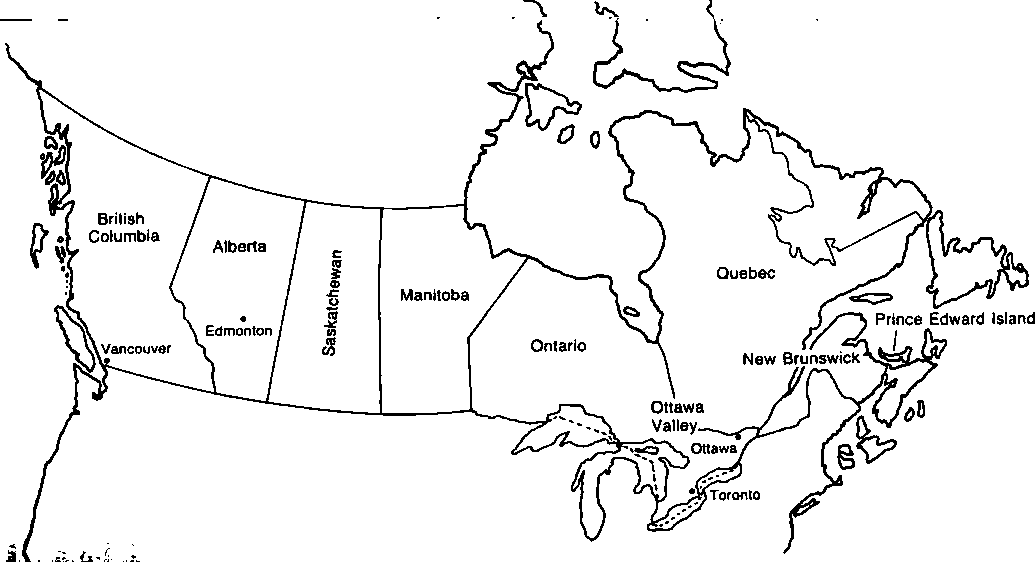
- •American english: Матеріали до вивчення курсу
- •Contents
- •1.1. English as it exists today
- •1.2. Dialects vs variety/variation
- •1.3. English in america
- •The languages of the usa and canada
- •1.3.1. Canadian English
- •1.3.2. Regional varieties of Canadian English
- •1.3.3. Regional varieties of English in the usa
- •1.4. Social variations of american english
- •1.5. Ethnic varieties of american english
- •1.5.1. Native American English
- •1.5.2. Spanish-influenced English
- •1.5.3. Black English
- •1.6. Male-female differences
- •1.6.1. Approaches to the Explanation of Cross-Sex Difference
- •1.6.2. Differences encoded in language
- •1.6.3. How to Avoid Sexist Language
- •1.7. British and american english: differences in pronunciation
- •1.7.1. Differences in Phonetic Inventory
- •1.7.2. Differences in Quality of the Phonemes
- •1.7.3. Phonotactic Differences
- •Intervocalic /t/
- •1.7.4. Divergent Patterns of Phoneme Use in Sets of Words
- •1.7.5. Stress and Intonation
- •1.8. British english and american english: differences in morphology
- •1.8.1. Differences in the Verb
- •1.8.2. Differences in the Noun and Pronoun
- •1.8.3. Differences in the Preposition and the Adverbs
- •Time Expressions:
- •1.9. British english and american english: differences in lexis
- •British english and american english:
- •BrE fulfil, instil may be interpreted as simplification. In AmE we find double “ll” in fulfill, instill, but both forms are used in AmE install(l), install(l)ment.
- •BrE BrE
- •Individual Words which Differ in Spelling
- •Exercise 2
- •Exercise 3
- •Exercise 4
- •Exercise 5
- •Exercise 6
- •Exercise 7
- •Exercise 18
- •Exercise 19
- •1. Eastern New England
- •2. Middle Atlantic
- •3. Southern
- •4. North Central
- •5. Southern Mountain
- •Exercise 20
- •Exercise 21
- •List of Abbreviations
- •Glossary
1.3.1. Canadian English
J. Pringle in his work “The Concept of Dialect and the Study of Canadian English” writes that Canadian English is a solid part of the American branch of language. It shares most of the linguistic characteristics of American English yet there are important features of Canadian English which distinguish it as an independent subvariety of American English. Canadians have positive view of the US and there are some phenomena in common:
● syllable reduction:
E.g.: lion=line, warren=warn
● fewer high diphthongs in the words “about”, “like” /Qu/ - /Au/
● Canadians use more American morphological and lexical forms.
Pro-British attitudes correlate well with the preservation of vowel distinction before [r] such as “spear it” /'spIqrIt/ vs /'spirit/.
Pro-Canadian attitudes mean relatively more leveling of the vowel distinctions, more loss of /j/.
E.g.: tune /tju:n/ - /tu:n/
75% of Canadians say /zed/ instead /zi:/, 75% - chesterfield for sofa, 2/3 have sound /l/ in “almond”, 2/3 of Canadians say to bath a baby /ba:T/ (BrE), than /beiD/ (AmE). British English spelling is strongly favoured in Ontario and American English in Alberta. Thus differences between Canadian English and American English are largely in the area of pronunciation and vocabulary. Grammar differences don't exist on the level of Standard English.
Vocabulary provides a considerable number of Canadianisms. Designators for topography, flora and fauna make up many of these items: buffalo grass (бізонова трава), fambeau /fxm'bO/ (факел з березової кори), cutthroat (робітник, що розрізає рибу біля її голови), West-India fish (другий сорт тріски), Canada goose (канадська казарка), Canada jay (сіра сойка).
The pronunciation of Canadian English sometimes called General Canadian applies to Canada from Ottawa Valley to British Columbia and it is similar to General American English. It shares the same consonant system including the unstable contrast between /hw/ - /w/ which -wich. General Canadian vowel system is similar to that of the Northern variety of General American, i.e. opposition /O:/ - /O/ has been lost. The distinctions between /J/ - /i/, /eq/ - /e/ - /x/ are rapidly dying out. The most typical Canadian feature of pronunciation is Canadian raising. This refers to realization of diphthongs /au/, /ai/ with the higher and non-fronted first element /Au/, /Ai/ when followed by voiceless consonant, e.g. bout /bAut/.
1.3.2. Regional varieties of Canadian English

Canadian population is overwhelmingly middle class and urban and the bulk of it lives in the area westwards (to the west of Ottawa Valley). Working class usage differs from middle class but middle class preferences in Ottawa are strongly in the direction of American English.
E.g.: Loss of /j/ in “new” - /nu:/. Working class favors -in' not -ing and they level /hw/ and /w/.
The second major region of Canadian English is eastwards from the Ottawa Valley - Maritime Province, Nova Scotia and Prince Edward Island. Here the norms of pronunciation are varied. Ten distinct English language areas are distinguished here. These variations are explained by the settlement history (Scots, Northern and Southern Irish, Kashubian Poles, Germans and Americans). The eastern Canadian region is characterized overall as resembling the English of New England as the earliest settlers came from England. In this part there is less /O:/- /O/ leveling. English of this area like all of Canada is rhotic, i.e. /r/ is pronounced where spelt while Eastern New England is non-rhotic. The final distinct region of Canadian English is Newfoundland with the population 568000. Some scholars (e.g. Wells) speak of traditional dialects in Newfoundland. The linguistic identity of Newfoundland is the result of:
● early (1583 and onwards) and diverse (especially Irish and Southern English) settlement;
● the stability of the population (93% native born);
● isolation.
This territory joined Canada in 1949 and the influence of the mainland pronunciation patterns has become stronger. Examples of the Irish English influence are:
● monophthongal /e/ instead of /ei/, /O/-/Ou/, /A/ is rounded and retracted
● some speakers neutralize /ai/ and /Oi/. They are realized as /ai/
● dental fricatives /T/, /D/ are pronounced as /t/ and /d/
● /h/ is generally omitted except in standard speech
● consonant clusters are regularly simplified: post - /pous'/, land - /lxn/.
